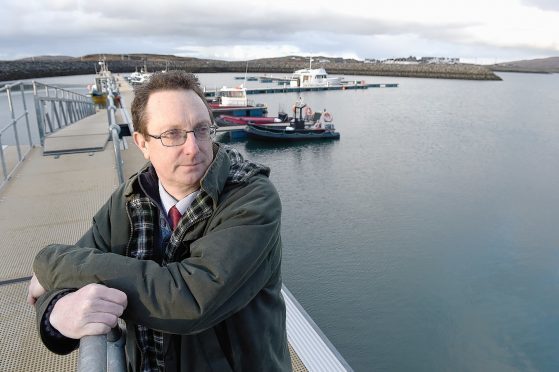From resurrecting an historic golf course and building a pier used by mega-rich yacht owners to running a windfarm and maintaining miles of drains – the job of the country’s biggest community landowner is nothing if not varied.
But these are just a few of the responsibilities of Storas Uibhist, which is preparing to celebrate its 10th birthday later this year.
On St Andrew’s Day in 2006, a group of community campaigners secured an unlikely £4.5million deal to take over the running of much of Benbecula, and most of South Uist and Eriskay from a group of nine families who had used them as a sporting holiday destination for 45 years.
Initially formed as “Uist 2000” in the 1990s to try to diversify the islands economy amid fears over the future of the local Ministry of Defence rocket range, the group won financial backing from the Lottery, Highlands and Islands Enterprise
(HIE), Scottish Natural Heritage and Western Isles Council to complete Scotland’s biggest community buy-out.
In doing so, Storas Uibhist – Gaelic for the store or wealth of Uist – became responsible for 93,000-acres of land, including 1,000 crofts, 30 commercial tenancies, three quarries, a 2,000-acre farm, as well as fishing, shooting and stalking businesses.
Sitting in the Storas offices at Daliburgh on South Uist, which were purchased for £180,000 from HIE in 2011 and are home to nine of the organisation’s 20 employees, chief executive Huw Francis reflected on what had been a busy decade.
“It’s probably been a lot harder work than anyone anticipated. It’s taken longer to get things delivered, but yeah, it’s going in the right direction. And hopefully it will continue to do so,” he said.
Mr Francis arrived on the islands from Wales in 2007, a few months after the buyout.
“I was an engineer. I’ve worked around the world – Hong Kong, Turkey, France, Wales, South Uist. So for the last 20 years English hasn’t been the first language,” he said.
“It’s an amazing place. It’s different, shall we say. The job is certainly varied and challenging.”
One of the first headline-grabbing projects facilitated by Storas Uibhist was the restoration of Askernish golf course, which was completed in 2008.
It had been designed in 1891 by the renowned “Old” Tom Morris, who helped create celebrated courses such as Carnoustie, Prestwick, Muirfield and Royal Dornoch, but became all but lost during the 20th century.
Today, it is attracting hundreds of visitors from around the world every year, eager to test themselves against the fierce winds and natural layout.
“It certainly is one of the key things that the buy-out was taken forward to facilitate. It brings in a lot people, a lot of money into the local economy,” said Mr Francis.
He said the group hoped to attract more visitors to the course in coming years but that transport issues – in particular the number and performance of ferry and air services – were holding back the islands.
So much so, Storas even considered starting up its own ferry service, before the Scottish Government finally agreed to look at bringing in a route between Lochboisdale and Mallaig.
“It has been something that we’ve thought about – running our own ferries,” said Mr Francis.
“We had been thinking if the Scottish Government wasn’t going to do it we could do it ourselves. Because people wanted it and needed it.”
A key decision in the first 10 years of Storas was the £11.5million installation of three wind turbines at Loch Carnan in 2013, with the 6.9MW towers now generating £2million of gross revenue every year, and between £800,000 and £1million in profit.
“That was a project that was designed to generate a revenue stream for us, so we can invest in other projects,” Mr Francis said.
“It’s delivering probably slightly better than was envisaged at the time, although there’s pressure from changes in things like the Climate Change Levy.”
Plans to expand the windfarm could double the revenue stream in coming years.
“We’ve got a planning application in for three further turbines. We’re aiming for the planning committee in February, so we’d probably get them up before April 2017,” Mr Francis said.
A £10million scheme to build a new marina at Lochboisdale has been another highlight for the community group.
Opened in May with 51 pontoon berths, the facility is already attracting yacht owners and local fishermen – and Storas is planning a feasibility study into creating a deepwater berth there, and potentially a new ferry pier.
Looking forward to the next decade, Mr Francis said: “It’s a long process. Like a lot of the estates in Scotland there has been a long-term lack of investment in the estate infrastructure, and we’ve been trying to redress that.
“The drainage system requires a huge amount of work and we’ve started that, but it will require more.
“The money from the windfarm is coming in and we’re able to spend it on things like Lochboisdale, so that in itself will bring more tourists in, generate more money and create more jobs. So it’s a long-term investment.”
